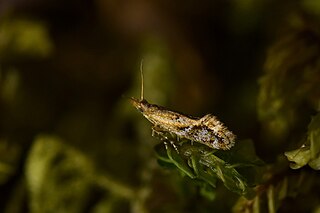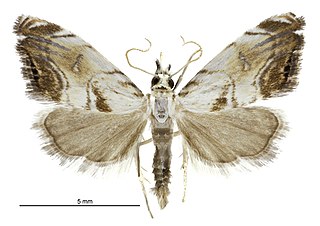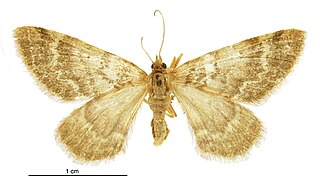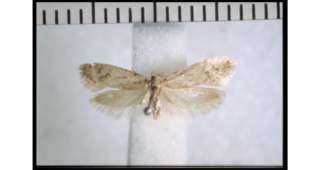
Sabatinca caustica is a species of moth belonging to the family Micropterigidae. It was described by Edward Meyrick in 1912. It is endemic to New Zealand and is found in both Southland and at Stewart Island / Rakiura. The adults of this species are variable in appearance with some specimens being mainly white on their forewings while others have forewings that are a more mottled purple-brown colour. Adults are on the wing from the start of October until the middle of December. Larvae feed on the surface of leafy liverworts.

Izatha prasophyta is a moth of the family Oecophoridae. It is endemic to New Zealand, where it is known from the North Island, except Hawkes Bay or the Wairarapa. Larvae likely feed on rotting wood although larvae of this species have been reared on the fruiting body of the bracket fungus Bjerkandera adusta. Adults are on the wing from November to February.

Mnesarchella acuta is a species of primitive moths in the family Mnesarchaeidae. It was described by Alfred Philpott in 1929, and is endemic to New Zealand. It is found in the Rangitikei, Wellington, Marlborough Sounds, Nelson, Buller, Westland, Kaikōura and north Canterbury regions. It is very similar in appearance to M. hamadelpha. This species lives in a variety of damp habitats in forests or near waterways that are not exposed to all day sunlight and can be found at altitudes ranging from sea-level up to 900 m. Adults are day flying and are on the wing from October to January.

Mnesarchella fusilella is a species of primitive moths in the family Mnesarchaeidae. It is endemic to New Zealand and can be found in the Northland, Auckland, Waikato, Bay of Plenty, Hawke's Bay, Whanganui, and Wellington regions. It prefers well lit damp forests or moist fern-covered banks and lives at altitudes ranging from sea-level to approximately 500 m. Adults are on the wing from October to December. This species is normally day flying but males have been collected at night via light trapping.

Mnesarchella loxoscia is a species of primitive moth in the family Mnesarchaeidae. It is endemic to New Zealand. and is found in the Northland, Auckland, Coromandel, Waikato, Bay of Plenty, Taranaki, Taupō, Gisborne, Rangitīkei, Wellington and the Marlborough Sounds regions. Adults of this species are normally on the wing from December and January but can be on the wing as early as October.

Mnesarchaea paracosma is a species of primitive moths in the family Mnesarchaeidae. It is endemic to New Zealand and can be found in the Kaikōura, mid and south Canterbury, MacKenzie, Otago Lakes, Central Otago, Dunedin, Fiordland and Southland areas. M. paracosma lives in a wide variety of habitats including tussock grasslands, shrubland, and damp native beech or podocarp forests, at a range of altitudes from around sea-level up to 1200 m. Adults of this species are on the wing from October to February and are day flying, although they are attracted to light at night.

Glaucocharis harmonica is a moth in the family Crambidae. This species was described by Edward Meyrick in 1888. It is endemic to New Zealand and is found in the North and South Islands. It inhabits lowland to subalpine native forest. It has been hypothesised that there are two broods per year. The larval hosts are unknown. Adults are on the wing from October until January.

Asaphodes aphelias is a species of moth in the family Geometridae. It is endemic to New Zealand and has been observed in Fiordland. This species inhabits damp native scrub and has been observed in upland wetlands at altitudes of between 800 and 1100 m. Adults are on the wing in February but the female of this species is unusual as it has narrow fore and hind wings.
Mnesarchella ngahuru is a species of primitive moth in the family Mnesarchaeidae. This species is endemic to New Zealand and is found in the Taupō, Gisborne and Wellington regions.

Tingena anaema is a species of moth in the family Oecophoridae. It is endemic to New Zealand and has been collected at Lake Wakatipu, Invercargill and Stewart Island / Rakiura. The adults of the species are on the wing in December.

Tingena crotala is a species of moth in the family Oecophoridae. It is endemic to New Zealand and is found both in the North and South Islands. This species inhabits native forest and is on the wing in November and December.

Tingena eumenopa is a species of moth in the family Oecophoridae. It is endemic to New Zealand and found in the North and South Islands. The adults have been found amongst tree ferns and are on the wing in December.

Tingena falsiloqua is a species of moth in the family Oecophoridae. It is endemic to New Zealand and has been collected in the North Island. This species frequents subalpine native forest.

Tingena horaea is a species of moth in the family Oecophoridae. It is endemic to New Zealand and have been observed in both the North and South Islands. The adults are on the wing in January.

Tingena pallidula is a species of moth in the family Oecophoridae. It is endemic to New Zealand and has been collected in the Nelson and Tasman regions. Adults of this species are on the wing in February and have been collected by beating undergrowth.

Tingena penthalea is a species of moth in the family Oecophoridae. It is endemic to New Zealand and has been observed in Wellington and the Tararua Range. The adults of this species are on the wing from December until February.

Atomotricha chloronota is a moth in the family Oecophoridae first described by Edward Meyrick in 1914. It is endemic to New Zealand and is found in the eastern side of the South Island and at the Antipodes Islands. It inhabits clearings with native tussocks and ferns. The larvae feed on leaf litter from silk tunnels in soil. The male adults of this species are on the wing from July to September and have been trapped via sugar traps and are attracted to light. The female of this species is brachypterous.

Trachypepla importuna is a moth of the family Oecophoridae first described by Edward Meyrick in 1914. It is endemic to New Zealand. Adults have been collected in the North Island in January but the species is regarded as being poorly known.

Trachypepla leucoplanetis is a moth of the family Oecophoridae first described by Edward Meyrick in 1883. It is endemic to New Zealand and has been collected in both the North and South Islands. It is the smallest moth species in the genus Trachypepla and the patterns on the forewings of adults are variable in appearance. It inhabits native forest and bush and the larvae feed on leaf litter. Adults are on the wing from October until February. T. leucoplanetis is regarded as being rarely observed and has been collected via the beating of foliage.

Trachypepla lichenodes is a moth of the family Oecophoridae first described by Edward Meyrick in 1883. It is endemic to New Zealand and has been found in both the North and South Islands. It inhabits native forest and adults of this species are on the wing from November to January. The adult moths are similarly coloured to native lichen species however this colouration is variable in the extent and depth on the forewings.





















